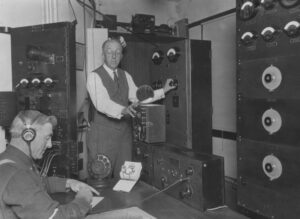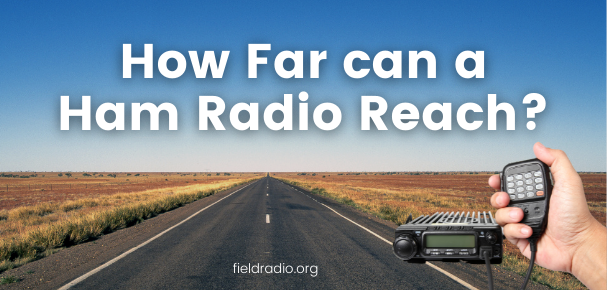Ham radio has a peculiar name. And if you are new to the ham radio universe, the peculiarity of this name may have left you curious about its etymology.
You may have wondered what the name ham radio stands for…
or even if it represents anything at all!
The name “Ham” can be dated back to 1908, where the first letter of each of the 3 radio pioneer’s first names was used to name it – Hertz, Amstrong and Marconi . However, it was also the station call sign of the Harvard Radio Club, who used the first letter of radio operators Hyman, Almy and Murray.
As you can see, the origins of the name ‘Ham’ are not clear cut!
In this article, we will discuss the real reason why Amateur radios are called Ham radios and uncovering false meanings so you really do know why is it really called a Ham radio today.
But first, let’s start with the basics.
What Are Ham Radios?
A Ham radio, formally known as Amateur radio, is a two-way communication device primarily used for non-commercial radiocommunications.
Ham radio operates on the designated amateur bands, which comprise certain frequencies allotted by the Federal Communications Commission FCC in the US.
Using a Ham radio is a hobby practiced by thousands of licensed operators across the US. These operators are called Hams.
Why?
I’ll get to that in a bit.
For now, don’t be offended when someone calls you a Ham once you get your Amateur radio license.
Okay, let’s back up a little and address the important question next.
Why Are Ham Radio Operators Called Hams?
More often than not, people refer to Amateur radio operators as “Hams”. And being new to the Ham radio world, this may seem not very kind to you.
The word “Ham” was indeed meant to be derogatory when it first came out.
Back in the early days of Amateur radio, commercial radio operators used the word “Ham” when referring to the non-commercial Amateur radio operators as an insult.
But things changed.
Over time, forward-thinking and broad-minded amateur radio operators embraced the seemingly insulting name and started taking pride in it.
This eventually eliminated the negative connotation.
And once the amateur radio community embraced the derogatory term, the world stopped using it as an insult, at least for them.
Now, let’s dive into what we are all here to discuss.
What Does Ham Radio Stand for?
Ham radio has many false etymologies associated with it.

Some people say that the word HAM was the callsign of one of the first amateur radio operators, Albert S. Hyman, Bob Almy, and Poogie Murray.
They say their callsign was adopted as the name of this radio communication method because Albert Hyman prevented Amateur radio from going extinct.
According to this legend, Hyman gave a speech in congress sometime around 1911, due to which, he managed to defeat a bill that, if passed, would have wiped the existence of Amateur radio.
In recognition of Hyman’s “efforts”, Amateur radio enthusiasts adopted their callsign “HAM” as the name for their radio communication techniques.
As good as this story sounds, and as hard as we want it to be true, this story is far from being authentic.
Some researchers have gone as far as checking the congress reports from the dates they say Hyman made a speech and have even checked the alumni book of Harvard radio club. But neither have they found any record of the “speech” nor have they been able to locate Hyman, Almy, and Murray in the Alumni book. ☹
According to the next etymology, the phrase “Ham radio” stems from the term “Ham-fisted” that commercial radio stations used for Hams who had weak morse code transmission skills. However, again, there is no proof that supports this story.
Apart from these popular false etymologies, another story explains why it’s called a Ham radio. And I find this one the most ridiculous.
According to this tale, the word Ham was chosen for amateur radio to honor the three pioneers of radio, namely, Hertz, Armstrong, and Marconi.
However, Edwin Armstrong (born 1890) may have been a high school or college student, yet to become the “pioneer” of radio when the term Ham radio for Amateur radio surfaced.
All of these etymologies are folktales that probably originated in someone’s mind and have traveled via word-of-mouth through the years.
Now, coming to the accurate etymology.
The word Ham was used to refer to an incompetent or poorly-skilled person back in the late 19th century.
According to Amateur Radio Relay League’s (ARRL) website, in the early days of Ham radio, all commercial and non-commercial radio stations occupied the entire spectrum and hence, competed for time and signal.
Many amateur stations at that time were more powerful than other commercial stations, and hence, when two Hams were on the air, they would jam the frequencies for all other users.
Frustrated, these people started referring to amateur radio users as “Hams”.
Now, since amateur radio operators were called Hams, their devices took the name “Ham radios”.
This is the humble origin of the term Ham radio.
Not too dramatic, is it?
Now, since we have taken a trip down the 19th and 20th-century lane in this section, you must be thinking about how old ham radio actually is.
So, that’s what I’ll shed light on next.
How Old Is Ham Radio?
Ham radio is old enough to be the great grandfather of the modern mobile.
That’s right.
Amateur radio is centuries old.
The first known use of an amateur radio dates back to the late 19th century. But its popularity grew in the early 20th century when Guglielmo Marconi sent the first trans-Atlantic wireless signal in 1901.
Since then, Ham radio has seen gradual development, only halting during the first world war.
What is a Ham Radio Used for?
You have read this far to know what Ham radio stands for. Now, you almost owe it to yourself to quickly find out what it all does, no?
A Ham radio finds use in non-commercial applications, such as:
- Recreational activities. Hams like to connect with other Hams and chat. You can also use your Ham radio as a walkie-talkie and turn it into a mobile communication device.
- Learning and teaching. Ham radio hobby teaches valuable skills and helps people delve deeper into antenna types and systems, modulation technique, electronics, propagation theory and practice, radio communication and etiquettes, and whatnot.
- Emergency communication. Ham radio does not rely on the modern communication infrastructure. It hence serves as an important emergency communication device to keep people connected during disasters that knock out the communication infrastructure.
Conclusion
Ham radio’s unusual name has long been a reason for speculation about its etymology.
Many tales explain the origin of the term “Ham” in ham radio in a dramatic way. But these stories, despite being more interesting for some people, are unreliable, at best.
I have attempted to squish false stories in this article and have discussed the real origin of the term “Ham radio”.
Hopefully, this would have helped you to understand why it is called a Ham radio and where the term truly stems from.

I have been passionate about the world of communications in its various forms for most of my life. Ever since I first found an old ham radio stashed away in my uncle’s attic, I have had a fascination with this classic technology.
Having the ability to communicate with people without the need to rely on telephone lines or networks is an empowering feeling which I believe everyone should have at least a basic knowledge of. Becuase who knows when you might need it?
I setup fieldradio.org with this passion in mind, to help inform people about the amazing possibilities of amateur radio and I’m on a quest to help educate as many budding operators as possible.
I hope you enjoy our content. Come and say hi, via our contact form



